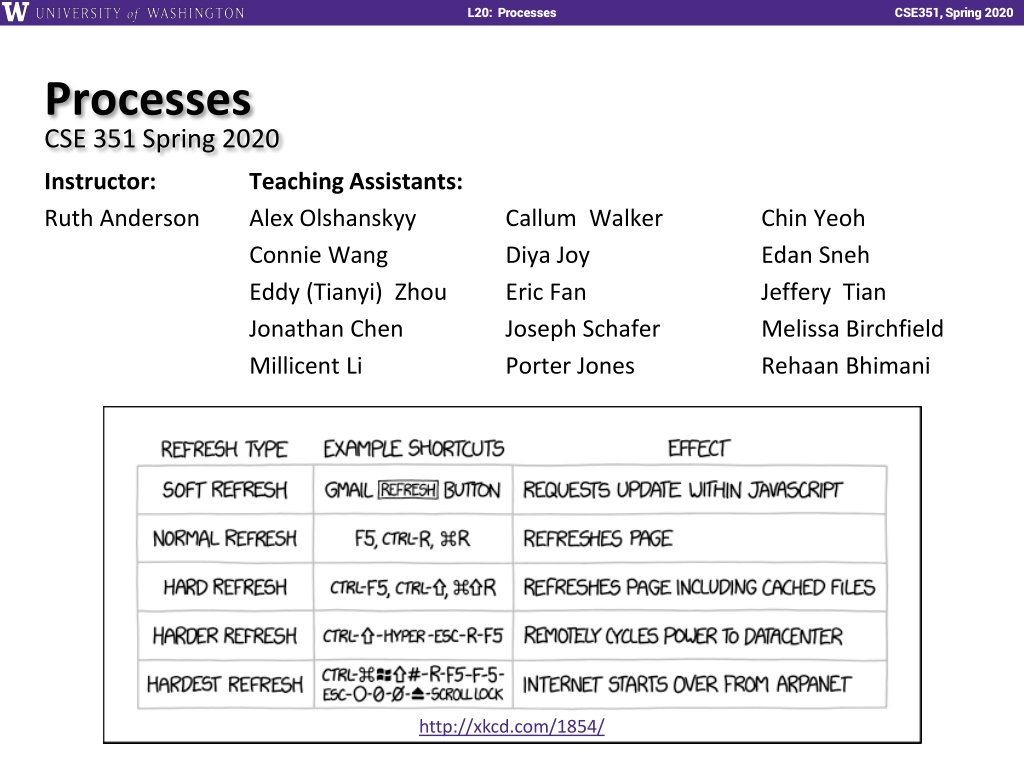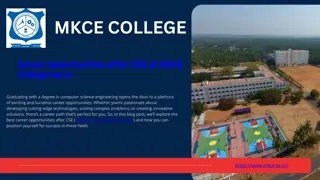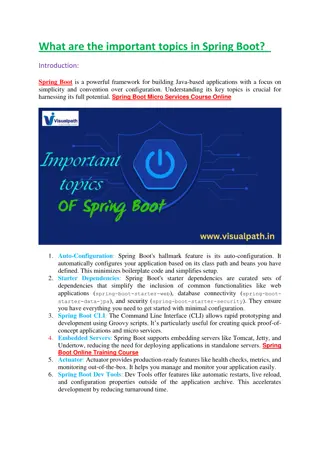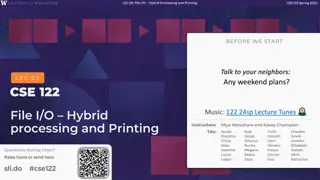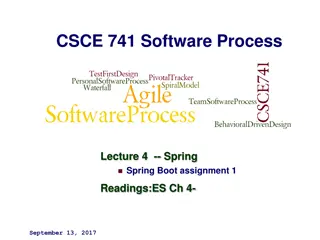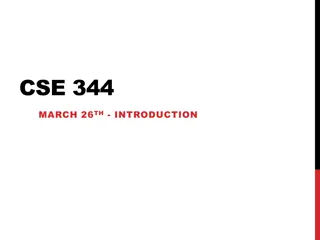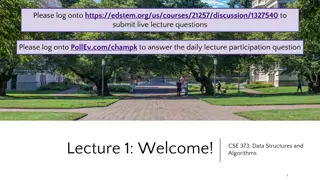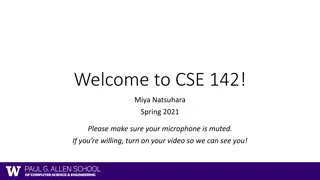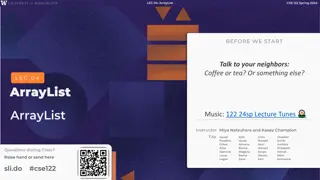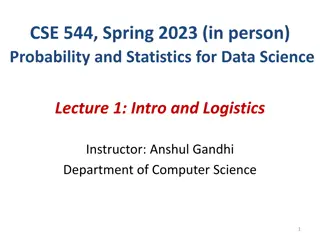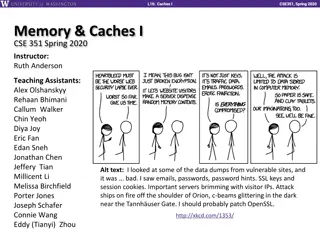Overview of CSE 351 Processes in Spring 2020
Processes in CSE 351 Spring 2020 cover topics like memory management, control flow, system components, and exceptional control flow. The course includes hands-on labs, assignments, and lectures focusing on memory allocation, Java vs. C, assembly language, processors, and more. Students are required to log in with their university Google account to access course materials. The content emphasizes the importance of understanding how control flows within a computer system, especially in handling multiple programs running concurrently and implementing multi-process applications.
Download Presentation

Please find below an Image/Link to download the presentation.
The content on the website is provided AS IS for your information and personal use only. It may not be sold, licensed, or shared on other websites without obtaining consent from the author.If you encounter any issues during the download, it is possible that the publisher has removed the file from their server.
You are allowed to download the files provided on this website for personal or commercial use, subject to the condition that they are used lawfully. All files are the property of their respective owners.
The content on the website is provided AS IS for your information and personal use only. It may not be sold, licensed, or shared on other websites without obtaining consent from the author.
E N D
Presentation Transcript
L20: Processes CSE351, Spring 2020 Processes CSE 351 Spring 2020 Instructor: Ruth Anderson Teaching Assistants: Alex Olshanskyy Connie Wang Eddy (Tianyi) Zhou Jonathan Chen Millicent Li Callum Walker Diya Joy Eric Fan Joseph Schafer Porter Jones Chin Yeoh Edan Sneh Jeffery Tian Melissa Birchfield Rehaan Bhimani http://xkcd.com/1854/
L20: Processes CSE351, Spring 2020 Administrivia Lab 3 due TONIGHT, Wednesday (5/13) Lab 4 coming soon! Cache parameter puzzles and code optimizations hw17 due Friday (5/15) Lab 4 preparation! You must log on with your @uw google account to access!! Google doc for 11:30 Lecture: https://tinyurl.com/351-05-13A Google doc for 2:30 Lecture: https://tinyurl.com/351-05-13B 2
L20: Processes CSE351, Spring 2020 Roadmap C: Memory & data Integers & floats x86 assembly Procedures & stacks Executables Arrays & structs Memory & caches Processes Virtual memory Memory allocation Java vs. C Java: Car c = new Car(); c.setMiles(100); c.setGals(17); float mpg = c.getMPG(); car *c = malloc(sizeof(car)); c->miles = 100; c->gals = 17; float mpg = get_mpg(c); free(c); Assembly language: get_mpg: pushq %rbp movq %rsp, %rbp ... popq %rbp ret OS: Machine code: 0111010000011000 100011010000010000000010 1000100111000010 110000011111101000011111 Computer system: 3
L20: Processes CSE351, Spring 2020 Leading Up to Processes System Control Flow Control flow Exceptional control flow Asynchronous exceptions (interrupts) Synchronous exceptions (traps & faults) 4
L20: Processes CSE351, Spring 2020 Control Flow So far:we ve seen how the flow of control changes as a single program executes Reality: multiple programs running concurrently How does control flow across the many components of the system? In particular: More programs running than CPUs Exceptional control flow is basic mechanism used for: Transferring control between processes and OS Handling I/O and virtual memory within the OS Implementing multi-process apps like shells and web servers Implementing concurrency 5
L20: Processes CSE351, Spring 2020 Control Flow Processors do only one thing: From startup to shutdown, a CPU simply reads and executes (interprets) a sequence of instructions, one at a time This sequence is the CPU s control flow (or flow of control) Physical control flow <startup> instr1 instr2 instr3 instrn <shutdown> time 6
L20: Processes CSE351, Spring 2020 Altering the Control Flow Up to now, two ways to change control flow: Jumps (conditional and unconditional) Call and return Both react to changes in program state Processor also needs to react to changes in system state Unix/Linux user hits Ctrl-C at the keyboard User clicks on a different application s window on the screen Data arrives from a disk or a network adapter Instruction divides by zero System timer expires Can jumps and procedure calls achieve this? No the system needs mechanisms for exceptional control flow! 7
L20: Processes CSE351, Spring 2020 This is extra (non-testable) material Java Digression Java has exceptions, but they re something different Examples: NullPointerException, MyBadThingHappenedException, throw statements try/catchstatements ( throw to youngest matching catch on the call- stack, or exit-with-stack-trace if none ) Java exceptions are for reacting to (unexpected) program state Can be implemented with stack operations and conditional jumps A mechanism for many call-stack returns at once Requires additions to the calling convention, but we already have the CPU features we need System-state changes on previous slide are mostly of a different sort (asynchronous/external except for divide-by- zero) and implemented very differently 8
L20: Processes CSE351, Spring 2020 Exceptional Control Flow Exists at all levels of a computer system Low level mechanisms Exceptions Change in processor s control flow in response to a system event (i.e. change in system state, user-generated interrupt) Implemented using a combination of hardware and OS software Higher level mechanisms Process context switch Implemented by OS software and hardware timer Signals Implemented by OS software We won t cover these see CSE451 and CSE/EE474 9
L20: Processes CSE351, Spring 2020 Exceptions An exception is transfer of control to the operating system (OS) kernel in response to some event(i.e. change in processor state) Kernel is the memory-resident part of the OS Examples: division by 0, page fault, I/O request completes, Ctrl-C User Code OS Kernel Code exception event current_instr next_instr exception processing by exception handler, then: return to current_instr, return to next_instr, OR abort How does the system know where to jump to in the OS? 10
L20: Processes CSE351, Spring 2020 This is extra (non-testable) material Exception Table A jump table for exceptions (also called Interrupt Vector Table) Each type of event has a unique exception number ? ?= index into exception table (a.k.a interrupt vector) Handler ? is called each time exception ? occurs Exception Table code for exception handler 0 code for exception handler 1 0 1 2 code for exception handler 2 ... ... n-1 code for exception handler n-1 Exception numbers 11
L20: Processes CSE351, Spring 2020 This is extra (non-testable) material Exception Table (Excerpt) Exception Number Description Exception Class 0 Divide error Fault 13 General protection fault Fault 14 Page fault Fault 18 Machine check Abort 32-255 OS-defined Interrupt or trap 12
L20: Processes CSE351, Spring 2020 Leading Up to Processes System Control Flow Control flow Exceptional control flow Asynchronous exceptions (interrupts) Synchronous exceptions (traps & faults) 13
L20: Processes CSE351, Spring 2020 Asynchronous Exceptions (Interrupts) Caused by events external to the processor Indicated by setting the processor s interrupt pin(s) (wire into CPU) After interrupt handler runs, the handler returns to next instruction Examples: I/O interrupts Hitting Ctrl-C on the keyboard Clicking a mouse button or tapping a touchscreen Arrival of a packet from a network Arrival of data from a disk Timer interrupt Every few milliseconds, an external timer chip triggers an interrupt Used by the OS kernel to take back control from user programs 14
L20: Processes CSE351, Spring 2020 Synchronous Exceptions Caused by events that occur as a result of executing an instruction: Traps Intentional: transfer control to OS to perform some function Examples: system calls, breakpoint traps, special instructions Returns control to next instruction Faults Unintentional but possibly recoverable Examples: page faults, segment protection faults, integer divide-by-zero exceptions Either re-executes faulting ( current ) instruction or aborts Aborts Unintentional and unrecoverable Examples: parity error, machine check (hardware failure detected) Aborts current program 15
L20: Processes CSE351, Spring 2020 System Calls Each system call has a unique ID number Examples for Linux on x86-64: Number Name read write open close stat fork execve _exit kill Description 0 Read file 1 Write file 2 Open file 3 Close file 4 Get info about file 57 Create process 59 Execute a program 60 Terminate process 62 Send signal to process 16
L20: Processes CSE351, Spring 2020 Traps Example: Opening File User calls open(filename, options) Calls __open function, which invokes system call instruction syscall 00000000000e5d70 <__open>: ... e5d79: b8 02 00 00 00 mov e5d7e: 0f 05 syscall # return value in %rax e5d80: 48 3d 01 f0 ff ff cmp ... e5dfa: c3 retq $0x2,%eax # open is syscall 2 $0xfffffffffffff001,%rax User code OS Kernel code %raxcontains syscall number Other arguments in %rdi, %rsi, %rdx, %r10, %r8, %r9 Exception syscall cmp Return value in %rax Open file Negative value is an error corresponding to negative errno Returns 17
L20: Processes CSE351, Spring 2020 Fault Example: Page Fault User writes to memory location int a[1000]; int main () { a[500] = 13; } That portion (page) of user s memory is currently on disk 80483b7: c7 05 10 9d 04 08 0d movl $0xd,0x8049d10 User code OS Kernel code handle_page_fault: exception: page fault movl Create page and load into memory returns Page fault handler must load page into physical memory Returns to faulting instruction: mov is executed again! Successful on second try 18
L20: Processes CSE351, Spring 2020 Fault Example: Invalid Memory Reference int a[1000]; int main() { a[5000] = 13; } 80483b7: c7 05 60 e3 04 08 0d movl $0xd,0x804e360 User Process OS exception: page fault handle_page_fault: movl detect invalid address signal process Page fault handler detects invalid address Sends SIGSEGV signal to user process User process exits with segmentation fault 19
L20: Processes CSE351, Spring 2020 Summary Exceptions Events that require non-standard control flow Generated externally (interrupts) or internally (traps and faults) After an exception is handled, one of three things may happen: Re-execute the current instruction Resume execution with the next instruction Abort the process that caused the exception 20
L20: Processes CSE351, Spring 2020 Processes Processes and context switching Creating new processes fork(), exec*(), and wait() Zombies 21
L20: Processes CSE351, Spring 2020 What is a process? It s an illusion! Process 1 Memory Stack Heap Data Code CPU %rip Registers Disk Chrome.exe 22
L20: Processes CSE351, Spring 2020 What is a process? Another abstraction in our computer system Provided by the OS OS uses a data structure to represent each process Maintains the interface between the program and the underlying hardware (CPU + memory) What do processes have to do with exceptional control flow? Exceptional control flow is the mechanism the OS uses to enable multiple processes to run on the same system What is the difference between: A processor? A program? A process? 23
L20: Processes CSE351, Spring 2020 Processes A process is an instance of a running program One of the most profound ideas in computer science Not the same as program or processor Process provides each program with two key abstractions: Logical control flow Memory Stack Heap Data Each program seems to have exclusive use of the CPU Provided by kernel mechanism called context switching Private address space Code CPU Each program seems to have exclusive use of main memory Registers Provided by kernel mechanism called virtual memory 24
L20: Processes CSE351, Spring 2020 What is a process? It s an illusion! Computer Process 3 Memory Process 2 Stack Heap Data Memory Process 4 Code Process 1 Stack Heap Data CPU Memory Memory Code Registers Stack Heap Data Stack Heap Data CPU Code Registers Code CPU CPU Registers Registers CPU Disk /Applications/ Chrome.exe Slack.exe PowerPoint.exe 25
L20: Processes CSE351, Spring 2020 What is a process? It s an illusion! Computer Process 3 Memory Process 2 Stack Heap Data Memory Process 4 Code Process 1 Stack Heap Data CPU Memory Memory Code Registers Stack Heap Data Stack Heap Data CPU Code Registers Code CPU CPU Registers Registers Operating System CPU Disk /Applications/ Chrome.exe Slack.exe PowerPoint.exe 26
L20: Processes CSE351, Spring 2020 Multiprocessing: The Illusion Memory Memory Memory Stack Heap Data Stack Heap Data Stack Heap Data Code Code Code CPU CPU CPU Registers Registers Registers Computer runs many processes simultaneously Applications for one or more users Web browsers, email clients, editors, Background tasks Monitoring network & I/O devices 27
L20: Processes CSE351, Spring 2020 Multiprocessing: The Reality Memory Stack Stack Stack Heap Data Heap Data Heap Data Code Code Code Saved registers Saved registers Saved registers CPU Registers Single processor executes multiple processes concurrently Process executions interleaved, CPU runs one at a time Address spaces managed by virtual memory system (later in course) Execution context (register values, stack, ) for other processes saved in memory 28
L20: Processes CSE351, Spring 2020 Multiprocessing Memory Stack Stack Stack Heap Data Heap Data Heap Data Code Code Code Saved registers Saved registers Saved registers CPU Registers Context switch 1) Save current registers in memory 29
L20: Processes CSE351, Spring 2020 Multiprocessing Memory Stack Stack Stack Heap Data Heap Data Heap Data Code Code Code Saved registers Saved registers Saved registers CPU Registers Context switch 1) Save current registers in memory 2) Schedule next process for execution 30
L20: Processes CSE351, Spring 2020 Multiprocessing Memory Stack Stack Stack Heap Data Heap Data Heap Data Code Code Code Saved registers Saved registers Saved registers CPU Registers Context switch 1) Save current registers in memory 2) Schedule next process for execution 3) Load saved registers and switch address space 31
L20: Processes CSE351, Spring 2020 Multiprocessing: The (Modern) Reality Memory Stack Stack Stack Heap Data Heap Data Heap Data Code Code Code Saved registers Saved registers Saved registers CPU CPU Multicore processors Multiple CPUs ( cores ) on single chip Share main memory (and some of the caches) Each can execute a separate process Registers Registers Kernel schedules processes to cores Still constantly swapping processes 32
L20: Processes CSE351, Spring 2020 Assume only one CPU Concurrent Processes Each process is a logical control flow Two processes run concurrently (are concurrent) if their instruction executions (flows) overlap in time Otherwise, they are sequential Example: (running on single core) Concurrent: A & B, A & C Sequential: B & C Process A Process B Process C time 33
L20: Processes CSE351, Spring 2020 Assume only one CPU User s View of Concurrency Control flows for concurrent processes are physically disjoint in time CPU only executes instructions for one process at a time However, the user can think of concurrent processes as executing at the same time, in parallel Process C Process C Process A Process B Process A Process B User View time 34
L20: Processes CSE351, Spring 2020 Assume only one CPU Context Switching Processes are managed by a shared chunk of OS code called the kernel The kernel is not a separate process, but rather runs as part of a user process In x86-64 Linux: Same address in each process refers to same shared memory location 35
L20: Processes CSE351, Spring 2020 Assume only one CPU Context Switching Processes are managed by a shared chunk of OS code called the kernel The kernel is not a separate process, but rather runs as part of a user process Context switch passes control flow from one process to another and is performed using kernel code Process A Process B user code context switch kernel code time user code context switch kernel code user code 36
L20: Processes CSE351, Spring 2020 Processes Processes and context switching Creating new processes fork() , exec*(), and wait() Zombies 37
L20: Processes CSE351, Spring 2020 Creating New Processes & Programs Process 1 Process 2 Memory Memory Stack Heap Data Stack Heap Data fork() Code Code CPU CPU Registers Registers exec*() Chrome.exe 38
L20: Processes CSE351, Spring 2020 Creating New Processes & Programs fork-exec model (Linux): fork() creates a copy of the current process exec*()replaces the current process code and address space with the code for a different program Family: execv, execl, execve, execle, execvp, execlp fork() and execve() are system calls Other system calls for process management: getpid() exit() wait(), waitpid() 39
L20: Processes CSE351, Spring 2020 fork: Creating New Processes pid_t fork(void) Creates a new child process that is identicalto the calling parent process, including all state (memory, registers, etc.) Returns 0 to the child process Returns child s process ID (PID) to the parent process Child is almost identical to parent: Child gets an identical (but separate) copy of the parent s virtual address space Child has a different PID than the parent pid_t pid = fork(); if (pid == 0) { printf("hello from child\n"); } else { printf("hello from parent\n"); } fork is unique (and often confusing) because it is called once but returns twice 40
L20: Processes CSE351, Spring 2020 Understanding fork() Process X (parent; PID X) Process Y (child; PID Y) pid_t fork_ret = fork(); if (fork_ret == 0) { printf("hello from child\n"); } else { printf("hello from parent\n"); } pid_t fork_ret = fork(); if (fork_ret == 0) { printf("hello from child\n"); } else { printf("hello from parent\n"); } 41
L20: Processes CSE351, Spring 2020 Understanding fork() Process X (parent; PID X) Process Y (child; PID Y) pid_t fork_ret = fork(); if (fork_ret == 0) { printf("hello from child\n"); } else { printf("hello from parent\n"); } pid_t fork_ret = fork(); if (fork_ret == 0) { printf("hello from child\n"); } else { printf("hello from parent\n"); } fork_ret = Y fork_ret = 0 pid_t fork_ret = fork(); if (fork_ret == 0) { printf("hello from child\n"); } else { printf("hello from parent\n"); } pid_t fork_ret = fork(); if (fork_ret == 0) { printf("hello from child\n"); } else { printf("hello from parent\n"); } 42
L20: Processes CSE351, Spring 2020 Understanding fork() Process X (parent; PID X) Process Y (child; PID Y) pid_t fork_ret = fork(); if (fork_ret == 0) { printf("hello from child\n"); } else { printf("hello from parent\n"); } pid_t fork_ret = fork(); if (fork_ret == 0) { printf("hello from child\n"); } else { printf("hello from parent\n"); } fork_ret = Y fork_ret = 0 pid_t fork_ret = fork(); if (fork_ret == 0) { printf("hello from child\n"); } else { printf("hello from parent\n"); } pid_t fork_ret = fork(); if (fork_ret == 0) { printf("hello from child\n"); } else { printf("hello from parent\n"); } hello from parent hello from child Which one appears first? 43
L20: Processes CSE351, Spring 2020 Summary Processes At any given time, system has multiple active processes On a one-CPU system, only one can execute at a time, but each process appears to have total control of the processor OS periodically context switches between active processes Implemented using exceptional control flow Process management fork: one call, two returns execve: one call, usually no return wait or waitpid: synchronization exit: one call, no return 44
